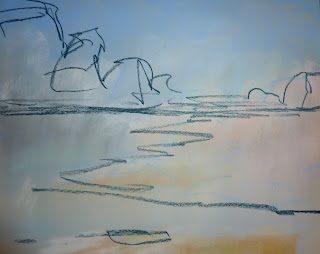 |
| 'Summer Will Come' 8x10 pastel plein air study ©Karen Margulis |
I am painting today from a plein air field study. The study was painted on a rainy day and it brought to mind the points I covered in this past blog article. I thought it was a good time to reshare. Enjoy this post from the archives!
Time is not always on our side. Especially when painting en plein air. When we paint outside we become a part of the very subject we are trying to capture on canvas (or paper). We are at the whim of Mother Nature. We have to deal with bugs, heat, cold, wind, rain to name just a few challenges faced by the intrepid plein air painter. Weather is a big challenge.
Weather is a challenge but it also influences the paintings we create. Challenging weather conditions can cause us to paint faster....and faster is sometimes better but it is always much different than slow.
I prefer painting quick small studies on location....field studies. I work fast trying to capture the essence of the scene. Like taking notes. So I embrace challenging weather. It forces me to work quickly. And I notice something in these fast weather driven paintings...they are fresh and loose and truly capture the feeling of the moment.
Take the paintings shown in today's post. They are all painted during my week in Finland all at the same spot. The only variable was the weather. They are all 8x10 pastels. Let's compare:
The painting above was painted as a demo in about 10 minutes. The goal was to show the class how I like to work to quickly to capture the feeling of the scene. I was drawn to the brightness in the sky that had suddenly appeared to break up the overcast sky. I had to work quickly to capture this shaft of light. Everything is just a suggestion. There is very little details in the trees. The main thing I wanted to remember was the shapes and colors. 10 minutes was enough to capture this. And it was a good thing because it quickly changed and the light was gone!
 |
| 'Summer Study Finland' 8x10 |
The painting above is the same location with a sightly different point of view. The weather was different this time. It was overcast with a gray sky filled with light clouds that were rolling and changing quickly. It was also windy. I wanted to capture the feel of the wind. I had more time to play with since there was no strong source of light. Conditions were constant....overcast and wind.
I spent more time on this painting. (maybe 30 minutes which is long for me) I concentrated on the trees and grasses. Since conditions were constant I had more time to develop them in greater detail. I added the bright spots on the water since it was also agitated by the wind.
The weather conditions gave me more time and so I took more notes!
 |
| 'Summer Study 2 Finland' |
In the last painting time was on my side. I was in the land of the midnight sun so the magic hour lasts for hours! The sun didn't set until around 2 am. Normally to capture a sunset we would need to paint quickly. For this painting the sunset conditions remained the same for hours! It was also very calm and still. I had more time to work at a slower pace (although I still chose to work quickly 30 minutes) But if I wanted I could have painted larger or painted a more developed painting.
Often we struggle with plein air because we try to do too much and we fight the weather conditions. Let the weather dictate how you respond to the scene and think about simply taking notes in paint when the weather isn't cooperating!



















































